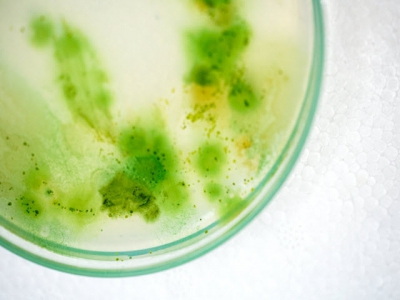From bench to belly: Driving supply-side solutions for the future of fish feed

Invest in and support alternate feed ingredients to ensure aquaculture’s future
Algae, as seen on this petri dish, is the source of one of the leading alternative feed ingredients for aquaculture feeds. Shutterstock image.
Disaster planning is a prudent practice for any business, and for governments. Aquaculture is not immune to disaster. Time and time again have we seen the collapse of burgeoning sectors , a trend that will continue into the future. These single-sector disasters usually involve disease (ISA in salmon in Chile, EMS in shrimp in Thailand) or natural phenomena (the Indonesian tsunami).
Any interruption in the availability of fish meal or fish oil could and will constrain production particularly for carnivorous species. Recent models have shown fisheries collapse under business as usual scenarios. A collapse of this supply would be a disaster.
In February, more than 100 aquaculture leaders met in San Francisco as part of the second meeting of the Future of Fish Feed (F3) challenge. After an opening keynote by Dr. Halley Froehlich on the “Status of Forage Fish Under ‘Business as Usual’ Scenarios”, participants were asked to address what would happen if we ran out of forage fish. This question was discussed in small groups, with each group reporting out their top ideas, and an artist captured those ideas on a large canvas.

Fig. 1: An artistic rendition of the potential solutions in the event of a disaster and we ran out of forage fish. Photo by Michael Tlusty.
Many of the solutions alluded to the theme of the meeting: to find alternatives, using innovation and systems or “synthetic” biology as solutions. However, during the discussion, some of the larger feed companies expressed confidence in their ability to persevere if fishmeal and oil were to be limited. These companies have conducted a number of studies to find alternatives to fishmeal and fish oil, and would be able to bring these solutions out of the vault and move to a production scenario in short order. When pressed for why they were not currently working with these solutions, it was a matter of finances, and the alternatives to fishmeal and fish oil are not currently cost effective.
With this peek into why alternative feed ingredients are not widely in use, a second breakout asked meeting participants to brainstorm how can all of the interesting and valuable research being conducted on alternate feed ingredients get from the laboratory bench to consumers’ bellies through market mechanisms. Each small group created a series of ranked solutions and each group was able to state their top two ideas for what was required to get innovative feed solutions to be a market reality.

Fig. 2: The artistic rendition of the break out discussion for how to get more innovative feeds from “Bench to Belly.”
As shown if Fig. 2, a lot of great ideas floated to the top of the individual groups. A few of the overarching comments coming from multiple groups include:
- Most consumers don’t care about feed. New innovations are adopted by influencers and the aquaculture-influencer audience needs to be identified to get products socially accepted.
- The flavor and nutrition of fish and shrimp fed alternative feed ingredients is important. Any new product to market has to be at minimum as good as existing products, and ideally has to taste better than conventional fed products.
- Alternate ingredients need to be able to scale and be of suitable cost. As we heard in the first breakout, ingredient companies have solutions at the ready, however, as long as low-cost-formulation is a strategy for feed creation, costs will dominate.
- Government regulations are still not conducive to making new ingredients available on the market in an expedient manner.
Above all else, aquaculture needs to tap into the existing market dynamics to get alternative feed ingredients to market. One way is to support sound ecosystem-based management for fisheries. In doing so, forage fishery harvests limits would be reduced to maintain ecosystem services. This would prevent overfishing, thus keeping a disaster from happening, while at the same time making the case that alternate ingredients are necessary.
A second way to tap into established market dynamics is to find retailers that value alternative feed ingredients and are willing to write contracts specifying the use of these ingredients.
Because of an uncertain future for ocean resources, and because aquaculture has an important place at the table for a food secure future, all of aquaculture – from laboratory research, to producer, to the markets, policy wonks and consumers – needs to make sure that there will be adequate resources to ensure production can grow to meet future global needs. Investment and support of alternate feed ingredients are the way to ensure a secure future for aquaculture.
Related news
 Global area estimate for marine aquaculture development
Global area estimate for marine aquaculture development Currently, 112 countries and territories produce seafood in the marine environment, with earnings reaching $65.4 billion in 2013 from the mariculture sector
 Shrimp pond preparation crucial for production, disease prevention
Shrimp pond preparation crucial for production, disease prevention Ponds accumulate soil particles eroded from earthwork and organic matter originating from dead plankton, uneaten feed and feces.
 The blue dimensions of aquaculture
The blue dimensions of aquaculture Aquaculture has been responsible for the growth in supply of fish for human consumption. In order to meet the demand for food for a growing global population